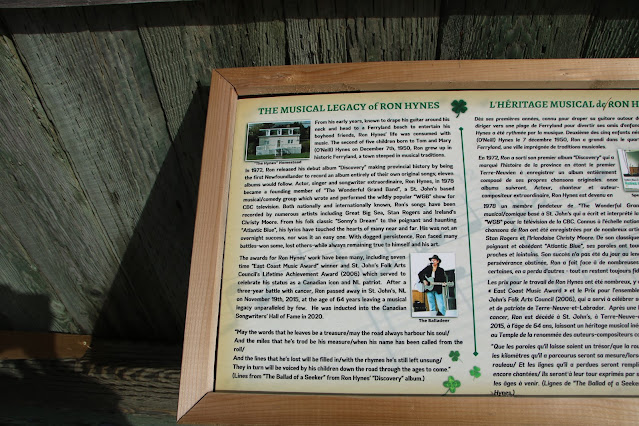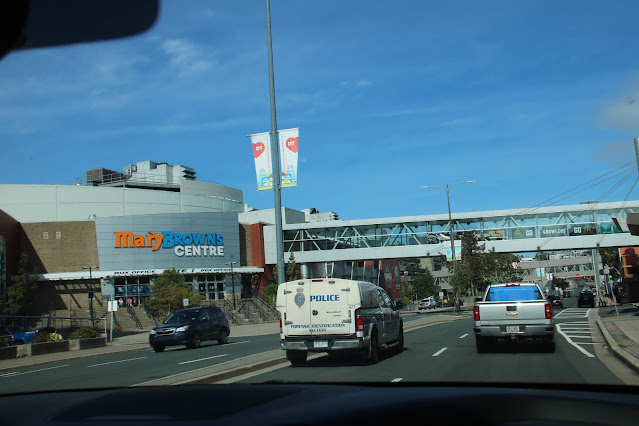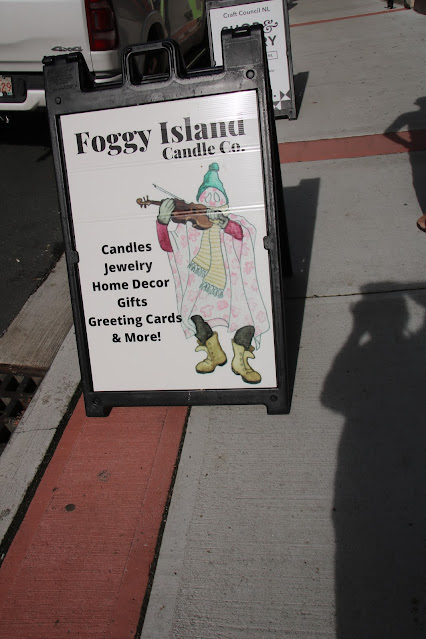Friday Sep 23 2022 - St. John's NL
We weren't supposed to get to St. John's until the 23rd but we changed our plans based on Hurricane Fiona's forecast as of September 21 and booked an extra night at the Hilton Garden Inn.
Its name has been attributed to the belief that John Cabot sailed into the harbour on the Nativity of John the Baptist in 1497, although it is most likely a legend that came with British settlement. A more realistic possibility is that a fishing village with the same name existed without a permanent settlement for most of the 16th century. Indicated as São João on a Portuguese map from 1519, it is one of the oldest cities in North America. It was officially incorporated as a city in 1888.The city has a rich history, having played a role in the Seven Years' War, the American Revolutionary War, and the War of 1812.
Italian inventor Guglielmo Marconi received the first transatlantic wireless signal in St. John's.
Its history and culture have made it into an important tourist destination. St. John's was referred to as Baile Sheáin (Johnstown), in the poetry of Donnchadh Ruadh Mac Conmara (1715–1810), and among speakers of the Irish language in Newfoundland.
John had wanted to get an oil change but there were no appointments available. We decided to drive some of the Irish Loop instead.
The Southern Shore was one of the first areas of Newfoundland to be exploited by European migratory cod fishermen (Portuguese, English and French). Most of the oldest toponyms are Portuguese in origin. By the late 16th century the Southern Shore was dominated by migratory fishermen from the West of England and became part of the so-called “English Shore”. In the 17th century the English attempted a series of formal colonies, among them, St. John’s, Ferryland, Renews, Aquarforte, and Bay Bulls. When these schemes failed as economic ventures some were left behind and were joined subsequently by other settlers (known as planters) including after the 1720s increasing numbers from Ireland. By the 1750s the Southern Shore, Trepassey Bay and St. Mary’s, the whole Southern Avalon, was predominantly Irish, and had become, de facto the “Irish Shore”. It has remained predominantly Irish in culture and tradition ever since, hence the appropriate moniker the “Irish Loop”.
The Southern Shore was one of the first areas of Newfoundland to be exploited by European migratory cod fishermen (Portuguese, English and French). Most of the oldest toponyms are Portuguese in origin. By the late 16th century the Southern Shore was dominated by migratory fishermen from the West of England and became part of the so-called “English Shore”. In the 17th century the English attempted a series of formal colonies, among them, St. John’s, Ferryland, Renews, Aquarforte, and Bay Bulls. When these schemes failed as economic ventures some were left behind and were joined subsequently by other settlers (known as planters) including after the 1720s increasing numbers from Ireland. By the 1750s the Southern Shore, Trepassey Bay and St. Mary’s, the whole Southern Avalon, was predominantly Irish, and had become, de facto the “Irish Shore”. It has remained predominantly Irish in culture and tradition ever since, hence the appropriate moniker the “Irish Loop”.
We left the Trans Canada Highway and took NL 13.
Then route 10. Bay Bulls is where we had scheduled our boat ride but cancelled due to Hurricane Fiona. It looked like we could have taken it, no rain in the forecast.
I took this photo on the way back down when I wasn't so white-knuckled.
Ferryland Head Light is an active lighthouse on Avalon Peninsula, southeast of the village of Ferryland, built in 1871. It is situated at the end of a long peninsula that juts into the sea.
Located roughly midway between Cape Spear and Cape Race, Ferryland Head was an ideal location for a lighthouse, being itself an obstacle for mariners. In the spring of 1859, “An Act to provide for the erection of a Lighthouse on or near Ferryland Head” was passed by the Legislative Council and Assembly that authorized the construction of the lighthouse using light dues, but it would be a decade before the project was started. During 1869, William Campbell and Thomas Burridge were awarded a contract for building the light tower and dwelling, a road from Ferryland Beach to the construction site was put in, and arrangements were made with lighthouse engineers David and Thomas Stevenson of Edinburgh, Scotland to provide a lantern room and lens.
It is a 25 minute hike to the lighthouse so we didn't.
Founded by Lord Baltimore in 1621, Ferryland is not only one of the most historic communities in Newfoundland, but in all of North America. Here too, was the birthplace of religious tolerance and freedom of worship in the New World. Incorporated in 1971, Ferryland now has a population of just over 400 people.
We headed back to St. John's for a late lunch.
Click here for lunch.Our hotel.
This is a very hilly town.
The forecast looks like Hurricane Fiona will bypass us.





































Beautiful views of the area.
ReplyDelete